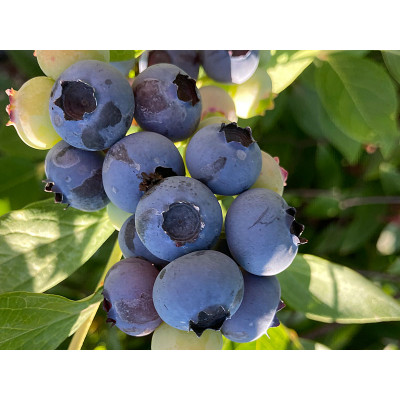Slivky a mirabelky
Brand: Tutifruti
Dostupnosť: Na sklade
Slivka 'Aroma Spur Gelb' je stĺpovitá odroda, ktorá je ideálna pre malé záhrady, terasy alebo balkóny. Táto jedinečná bio slivka so žltými plodmi sa v..
- Výška pri predaji: 160cm
- Kontajner: 7l
- Predávame ako: 2 ročný
- Doba dozrievania: August/September
Cena
32,00€
Brand: Tutifruti
Dostupnosť: Na sklade
Slivka 'Aroma Spur Rot' je ideálnou voľbou pre malé záhrady, balkóny a terasy, kde je potrebné šetriť priestorom. Tento stĺpovitý ovocný strom sa vy..
- Výška pri predaji: 160cm
- Kontajner: 7l
- Predávame ako: 2 ročný
- Doba dozrievania: August/September
Cena
32,00€
Brand: Tutifruti
Dostupnosť: Na sklade
BIO Slivka neskorá AROMA SPUR je stĺpová odroda slivky. Má výbornú kvalitu plodov. Je vhodná na pestovanie malých záhradách s nedosta..
- Výška pri predaji: 160cm
- Kontajner: 7l
- Predávame ako: 2 ročný
Cena
32,00€
Brand: Tutifruti
Dostupnosť: Na sklade
BIO Slivka skorá AROMA SPUR je stĺpová odroda slivky. Má výbornú kvalitu plodov. Je vhodná na pestovanie malých záhradách s nedostatk..
- Výška pri predaji: 160cm
- Kontajner: 7l
- Predávame ako: 2 ročný
Cena
32,00€
Dostupnosť: Na sklade
V našej oblasti menej známy hybrid stĺpovej slivky KOLONOVIDNAJA Je vhodná pre záhradkárov do okrajových oblastí, so chladnými zimami ..
- Výška pri predaji: 160cm
- Kontajner: 5l
- Podpník: Myrobalan
- Predávame ako: 1 ročný
Cena
28,00€
Dostupnosť: Na sklade
V našej oblasti menej známy hybrid myrobalánu /japonskej slivky/ussurijskej slivky/čínskej slivky, SVERCHRANNAJA. Nová vysoko úrodná odroda hybr..
- Výška pri predaji: 160cm
- Kontajner: 5l
- Podpník: Myrobalan
- Predávame ako: 1 ročný
Cena
28,00€
Dostupnosť: Na sklade
Slivka AMERS je obľúbená odroda sliviek. Patrí medzi neskoré odrody sliviek. Je známa svojou vynikajúcou chuťou a vôňou. Jej pôvod nájdeme v USA.Strom..
- Výška pri predaji: 160cm
- Kontajner: 5l
- Podpník: Myrobalan
- Predávame ako: 2 ročný
Cena
24,00€
Dostupnosť: Na sklade
Slivka BLUEFREE je hybridnou odrodou, vyšľachtenou v USA. Vznikla krížením odrôd President x Stanley.Strom slivky BLUEFREE je stredne veľký. Koru..
- Výška pri predaji: 160cm
- Kontajner: 5l
- Podpník: Myrobalan
- Predávame ako: 2 ročný
Cena
24,00€
Dostupnosť: Na sklade
Slivka HERMAN je veľmi skorou odrodou, ktorá pochádza zo Švédska. Má sladké plody a všestranné využitie. Strom slivky odrody HERMAN je obvykle st..
- Výška pri predaji: 160cm
- Kontajner: 5l
- Podpník: Myrobalan
- Predávame ako: 2 ročný
Cena
24,00€
Dostupnosť: Na sklade
Slivka STANLEY je stará, osvedčená a obľúbená odroda sliviek. Je známa svojou vynikajúcou chuťou a vôňou. Slivka STANLEY bola vyšľachtená v USA v roku..
- Výška pri predaji: 160cm
- Kontajner: 5l
- Podpník: Myrobalan
- Predávame ako: 2 ročný
Cena
24,00€
Brand: Tutifruti
Dostupnosť: Na sklade
Slivka FRUCA je stĺpová odroda slivky. Má výbornú kvalitu plodov. Je vhodná na pestovanie malých záhradách s nedostatkom miesta, ale môžeme..
- Výška pri predaji: 160cm
- Kontajner: 5L
- Predávame ako: 2 ročný
Cena
26,00€
Brand: Tutifruti
Dostupnosť: Na sklade
Odroda slivky s názvom "IMPERIAL" je stĺpová a vyniká v kvalite svojich plodov. Ideálna je pre pestovanie v malých záhradách s obmedzeným priestorom a..
- Výška pri predaji: 160cm
- Kontajner: 5L
- Predávame ako: 2 ročný
Cena
26,00€
Dostupnosť: Pripravujeme
V našej oblasti menej známy hybrid myrobalánu /japonskej slivky/ussurijskej slivky/čínskej slivky, GEK. Patrí medzi nové odrody, vyšľachtená bol..
- Výška pri predaji: 130-160cm
- Kontajner: 5l
- Podpník: Saint Julien A
- Predávame ako: 2 ročný
- Predpokadaný dátum predaja: Máj
Cena
23,00€
Dostupnosť: Pripravujeme
Japonská slivka NAJDENA je odroda získaná na Ukrajine, ktorá je výsledkom kombinácie slivky „Skorowodnaya“ a slivky „Desertnaya“. Ide o ďalšiu odrodu,..
- Výška pri predaji: 160cm
- Kontajner: 5L
- Podpník: Myrobalan
- Predávame ako: 2 ročný
Cena
28,00€
Dostupnosť: Pripravujeme
Marhulo-slivka 'Melitopolskij Černyj' (Prunus cerasifera x Armeniaca vulgaris) je jedinečný interšpecifický hybrid medzi sibírskou slivkou a marhuľou,..
- Výška pri predaji: 160cm
- Kontajner: 5l
- Podpník: Myrobalan
- Predávame ako: 2 ročný
- Stav Produktu: Júl
- Predpokadaný dátum predaja: Máj
Cena
28,00€
Brand: Tutifruti
Dostupnosť: Pripravujeme
V našej oblasti menej známy hybrid slivky a marhule, GLOBUS pochádza z Ukrajiny, stredne skorá odroda GLOBUS je vhodná aj do oblastí ..
- Výška pri predaji: 160 cm
- Kontajner: 5l
- Podpník: Saint Julien A
- Predávame ako: 1 ročný
- Predpokadaný dátum predaja: Máj
Cena
28,00€
Dostupnosť: Pripravujeme
Slivka 'Joganta' (Prunus domestica 'Joganta') je samoopelivá odroda, vyšľachtená v Nemecku krížením odrôd 'Jojo' a 'Haganta' . Táto odroda je známa s..
- Výška pri predaji: 160cm
- Kontajner: 5l
- Podpník: Myrobalan
- Predávame ako: 2 ročný
- Stav Produktu: August/September
- Predpokadaný dátum predaja: Máj
Cena
24,00€
Dostupnosť: Pripravujeme
Slivka domáca ( Prunus domestica ) 'Jubileum' na podpníku Myrobalán je švédska odroda, ktorá vyniká veľkými a šťavnatými plodmi, vysokou odolnosťou v..
- Výška pri predaji: 160cm
- Kontajner: 5l
- Podpník: Myrobalan
- Predávame ako: 2 ročný
- Doba dozrievania: August
Cena
24,00€
Dostupnosť: Pripravujeme
Slivka 'Královná Viktória' (Prunus domestica 'Queen Victoria') je stará anglická odroda ringloty, známa svojimi veľkými plodmi a vynikajúcou chuťou. ..
- Výška pri predaji: 160cm
- Kontajner: 5l
- Podpník: Myrobalan
- Predávame ako: 2 ročný
- Doba dozrievania: August/September
- Predpokadaný dátum predaja: Máj
Cena
24,00€
Dostupnosť: Pripravujeme
Slivka 'Nenka' (*Prunus domestica* 'Nenka') je ukrajinská odroda vyšľachtená v Mliivskom inštitúte sadovníctva ako semenáč z voľného opelenia odrody '..
- Výška pri predaji: 160cm
- Kontajner: 5l
- Podpník: Myrobalan
- Predávame ako: 2 ročný
- Stav Produktu: August
- Predpokadaný dátum predaja: Máj
Cena
28,00€
Dostupnosť: Pripravujeme
Slivka 'Vengerka Kornejewskaja' (Prunus domestica 'Vengerka Kornejewskaja') je stredne skorá samoopelivá odroda, vyšľachtená na Ukrajine krížením odr..
- Výška pri predaji: 160cm
- Kontajner: 5l
- Podpník: Myrobalan
- Predávame ako: 2 ročný
- Stav Produktu: August
- Predpokadaný dátum predaja: Máj
Cena
28,00€
Dostupnosť: Pripravujeme
Slivka 'Węgierka Dąbrowicka' je poľská odroda vyšľachtená v roku 1962 v Inštitúte sadovníctva a kvetinárstva v Skierniewiciach z výsevu 'Węgierki Zwyk..
- Výška pri predaji: 160cm
- Kontajner: 5l
- Podpník: Myrobalan
- Predávame ako: 2 ročný
- Stav Produktu: August
- Predpokadaný dátum predaja: Máj
Cena
28,00€
Dostupnosť: Pripravujeme
Slivka 'Węgierka Zwykła' je veľmi stará odroda neznámeho pôvodu, pravdepodobne pochádzajúca z Malej Ázie. Do Európy sa dostala vďaka vojnám a migráciá..
- Výška pri predaji: 160cm
- Kontajner: 5l
- Podpník: Myrobalan
- Predávame ako: 2 ročný
- Stav Produktu: September
- Predpokadaný dátum predaja: Máj
Cena
28,00€
Zobrazené 1 až 23 z 23 (1 stránok)


















































































